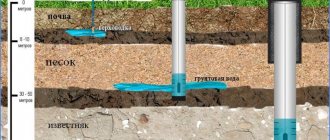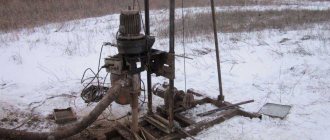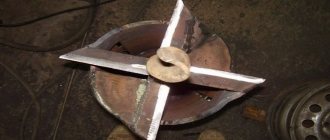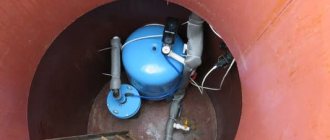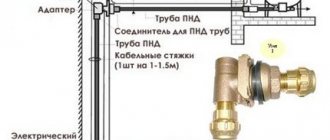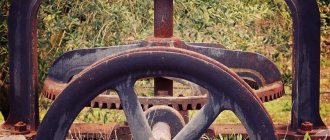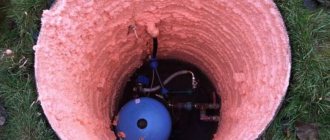A do-it-yourself airlift for a well is a very real device that will help ensure reliable operation of your own water source. The history of this technology goes back more than 200 years, and during this period it has proven its effectiveness. An airlift becomes an indispensable device if not a well, but a well, is built on a suburban area, but it does not provide the required volume of water. With proper calculation, the problem can be solved on your own.
The essence of technology
At its core, an airlift (aerolift) is a type of deep-well pump that ensures the rise of water due to its aeration. Its operation is based on a simple physical law: the specific gravity of the liquid after saturation with air decreases significantly, which facilitates its movement in the vertical direction. During operation of the device, the rising flow carries with it not only water, but also suspensions and sediment.
Such a pump works as follows: compressed air is supplied to the bottom part of the well (bottom hole) through a separate pipe. Water with air bubbles rises, and the speed of its rise and volume will depend on the pressure of the air stream and the amount of incoming air - the more air penetrates into the liquid, the higher the water loss parameters will be.
At the same time, the natural hydraulic process should be taken into account: the efficiency of the pump increases as the air saturates the liquid until a certain point when an optimal balance is achieved between the liquid and gas components of the medium. This balance corresponds to the maximum efficiency of the device. A further increase in the concentration of the air component is ensured only by an increase in pressure and does not cause a significant positive effect.
What are the advantages of airlifts for wells? Taking into account their characteristics, they can perform the functions of cleaning wells from silt and clay sediments, pumping a well with an airlift in order to purify water from sandy impurities, and it is also possible to pump water using the well principle.
This system allows you to lift water without using a deep-well pump, which is very important for small well diameters when the dimensions do not allow its immersion. With the help of bottomhole aeration, it is possible to increase the production rate of a well and revive it when the flow of water stops due to insufficient pressure in the aquifer. In addition, saturating water with oxygen can improve its quality .
It is impossible not to note some negative aspects of the technology under consideration. These include the following disadvantages: the need for constant air injection, which requires energy consumption for the operation of the compressor, increased pressure in the well has a negative effect on its walls, which somewhat reduces the service life, the likelihood of sand and silt rising with water when the bottom is contaminated.
Advantages and disadvantages
The main advantages of airlifts include the following points:
- Simple design features and no rubbing or moving mechanisms.
- Possibility of storing liquid in unlimited volume.
- Ease of installation and dismantling of equipment - the working parts of the system are connected using threads.
- Reliability and resistance to overgrowth.
- Ability to withstand exposure to chemical reagents and aggressive environments. This advantage is due to the use of special alloys in the production of airlift pipes.
In addition to the advantages, airlifts also have negative sides. Among them:
- Relatively low efficiency.
- A number of difficulties when pumping liquid from shallow wells.
The installations are also unable to pump out water in uniform portions, and the supply of sand and silt deposits remains uncontrolled.
Productivity does not depend on the intensity of the compressed air flow into the hydraulic structure, but on the thickness of the supply pipe and the depth of its immersion. When calculating an airlift, experts determine the optimal ratio of such parameters in order to obtain the highest percentage of efficiency.
Structural elements
Any airlift for lifting water from a well includes the following elements:
- compressor for air supply;
- steel pipe for delivering air to the bottom of the well;
- metal pipe for lifting aerated liquid;
- mixer providing connection of the air duct to the main pipe.
If you want to have high-quality water, a water purifier can be installed at the wellhead, which separates the gas component and solid impurities.
In principle, an airlift can have 3 different designs:
- separate pipe laying, when both pipes are immersed in the well in parallel, and their connection is made through one large hole, where the mixer is installed;
- the air duct is located inside the drainage pipe;
- the main pipe runs inside the air duct, and the water is saturated with air through the perforated lower section.
The choice of airlift design depends on the size of the well. The most common is the first option. Its version can be carried out without immersing the drainage pipe - its role is played by the well casing. In this case, an auxiliary alignment is drilled next to the main well to lower the pipe supplying air.
In general, the movement of a liquid saturated with gas is a complex hydrodynamic process. Therefore, to select a design, only the main technical parameters are taken into account. The following characteristics of standard airlifts for wells should be highlighted:
- productivity - ensured taking into account water needs, with optimal values being in the range of 20-50 cubic meters per hour;
- pipe diameter for lifting water: 60, 110 and 160 mm;
- duct diameter - 20-63 mm.
The correct choice of compressor largely determines the performance of the entire system. It must create air pressure at the bottom, capable of compensating for the pressure of the water column in the well. In addition, to saturate the liquid, it is also necessary to ensure an excess of 0.2-0.4 atm .
In order to pump the wellbore during cleaning, even greater pressure is needed. So, when installing an airlift in a drinking well with a depth of 50 m and a natural water level of 30 m, a compressor will be required that develops a pressure of about 2.5-2.6 atm.
Assembling the airlift
We perform all actions sequentially. We insert a curved metal tube into the smaller diameter hose. Secure the tube with a clamp. We insert the other end of the curved tube into a larger diameter hose from the side. The lower part of the larger diameter hose remains open - water will flow here. The hoses must be securely fixed relative to each other. To do this, you can use metal wire, plastic ties, and electrical tape. We connect the upper end of the thin hose to the compressor and secure it with a clamp. To check the functionality of the assembled device, lower it to its maximum working depth.
four-channel airlift
Air, entering from a narrow hose into a wide one, will rush upward, periodically filling the entire volume of the hose with a gas “piston”. A certain amount of water will remain on top of the “piston” and will be raised to the surface. This tendency of gas to rise in liquid is explained by the large difference in density. It is different for different gases and liquids. For example, the density of water is 800 times greater than the density of air. You can calculate what the buoyant force will be.
Principles of system calculation
A homemade airlift will perform its functions provided that the main characteristics are correctly calculated. To set up the system, you need to know the following parameters:
- The water level in a well is described by 2 main quantities: static level (H1) - the depth of the upper boundary of the water before the airlift operates, and dynamic level (H) - the depth to the water after the system starts.
- Depth of immersion of the air supply pipe. It consists of H and the depth of immersion in the water column (h), that is, H + h.
These parameters determine the choice of pressure that must be provided by the compressor.
In addition to the specified parameters, determining the performance of the installation is impossible without specifying some dimensions of the structural elements. The following quantities are important: the diameter of the well casing Ds, the diameter of the water-lifting pipe J and the diameter of the air duct Dv. These dimensions are interrelated and determine the volume of water raised (Vв).
Thus, with Dc up to 100 mm, Vc within 1-2 l/s is provided at J - 40 mm and Dv - 12 mm, and Vc is about 3 l/s with J - 50 mm and Dv - 13-20 mm. An increase in productivity occurs with larger well sizes, which makes it possible to use pipes of larger diameter. For example, Vc of the order of 9-12 l/s with Ds - up to 200 mm is achieved with J - 85-90 mm and Dv - 14-30 mm, and 22-32 l/s with Ds - 250 mm, J - 120-126 mm, Dv - 40-50 mm.
The immersion depth h is directly related to the total height of water rise. Thus, with a lifting height of up to 15 m, the ratio 100h/(h +H) is chosen to be about 67-72%; in the range of 16-30 m - 60-65%; 30-60 m - 50-59%; 60-90 m - 44-49%.
In addition, the h/H ratio determines the airlift efficiency. The maximum value of the coefficient (about 37.8%) can be expected at h/H - 2.2-2.25. At h/H=8.7 efficiency minimal (within 26.4-26.6%).
The pressure at the start of compressor operation is determined by the static level, that is, the height of the water column equal to H1, and during operation it can be reduced to a value corresponding to the dynamic level H. In this case, the H level is always significantly lower than the H1 level.
Another parameter that needs to be determined when designing a system is the required volume of air (Vв). It is usually calculated in the form: cubic meter of air for each cubic meter of water raised. The calculation is carried out according to the formula: Vв=Н/Сlg0.1(h+10), where C is the tabular coefficient associated with the amount of pipe immersion (it has a value from 8.4 to 14.3 when the immersion changes from 35 to 75%).
How much power does the compressor need?
The power of an air compressor is quite easy to calculate. It is necessary that the compressor power be in accordance with the pressure created by the water column in the well at the depth of water intake. As you know, when diving, every 10 m of water increases the pressure by 1 atmosphere. That is, if in a 50 m well the water is at a level of 30 m, then the air must be supplied at a pressure of more than 2 atm. It is not necessary to increase the pressure too much; about 0.2 atm is enough. This is explained by the fact that at very high pressure, more air than water will flow from the compressor through the supply hose. Be sure to adjust the air pressure from the compressor during a test pumping of water, find the most effective value.
System arrangement
The airlift is installed with your own hands, taking into account the given parameters and dimensions. The main pipe for lifting water with a diameter of 40-130 mm is selected. In the lower part, at a height of 10-20 cm from the end, a hole is formed into which the end of a pipe for supplying air with a diameter of 12-50 mm is inserted. The joint is carefully sealed.
Both pipes are immersed into the well to the required depth (H+h). The upper end of the air duct is connected to the compressor fitting. The pipes at the wellhead are securely fastened with clamps. Quite often, air supply is provided through a flexible hose.
In this case, it is pulled inside the metal duct pipe and inserted into the main pipe. When installing the system, it is recommended to provide for the possibility of deeper immersion of pipes during operation, with natural changes in the static level of groundwater.
When making an airlift with your own hands, you should prepare the following tools and equipment in advance: a welding machine, a grinder, a thread cutting tool, a device for bending pipes, pliers, a hammer, a screwdriver, a hacksaw for metal, a set of wrenches, files, a paint brush, an electric drill, a tape measure , metal ruler.
An airlift is a system capable of lifting water from a well without using a pump. You can do it yourself, for which you need to correctly determine the main technical parameters.
What is needed to make an airlift
To make an air water lift (airlift), we will need:
- air compressor
- two long hoses of different diameters
- bent metal tube
- fasteners (wire, clamps, ties, electrical tape)
Through a hose of smaller diameter, air from the compressor will be supplied to the well. Through a wider hose, the air-water mixture will rise to the surface.
one of the airlift options



